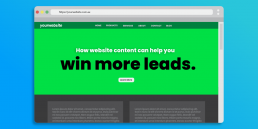The web is vast. As of now, there are billions of websites online, all competing for some share of the attention people give to their online browsing each day. When you’re starting a new website, it can be overwhelming to think about all the other websites out there. As you consider how best to build your own website, carefully consider what type of website you want it to be.
Here are two of the most popular types of websites you’ll see around the web. While there’s some overlap between the different categories, in general each type of website has certain goals to achieve and its own set of best practices.
E-commerce Website
An e-commerce website is a website people can directly buy products from. You’ve probably used a number of e-commerce websites before, most big brands and plenty of smaller ones have one. Any website that includes a shopping cart and a way for you to provide credit card information to make a purchase falls into this category.
If you’re setting up a website for your business and plan to sell your products through the site, then this is the type of website you need to build. There are some specific steps you have to be sure to include when building an ecommerce website, like investing in ecommerce software and getting your SSL certificate to ensure your customers can pay securely. And you’ll want to make sure your web design and copy are all crafted with the site’s main goal in mind
Business Website
A business website is any website that’s devoted to representing a specific business. It should be branded like the business (the same logo and positioning) and communicate the types of products and/or services the business offers.
By now, every business out there should have a website. It’s a widespread expectation. Every potential customer you encounter will just assume that if they Google your business looking for more information, they’ll find a website. And if they don’t, it makes the business look less professional or legitimate.
Key Elements
Whether you decide to DIY or have it done, big budget or small, here are 3 key elements of a modern website.
- User Experience
- Speed
- SEO
User Experience. Fondly called UX by many, user experience is about what type of experience your customers and perspective clients have on your site. Your website is your online brand ambassador, so you need to make sure it represents you in a good light. We’ve all been to plenty of sites where you just can’t find a thing light? This could be because of clutter, confusing verbiage and labelling, or even lack of or too much information. Below are some of the important considerations for good UX,
- Clean flow and layout. Make sure it’s easy for people to understand and navigate, allowing for the experience to be interactive and simple. No one wants to work hard for your phone number.
- User-friendly website navigation. Some of the best small business website designs are those that offer intuitive and user-friendly navigation features. Online users are almost always in a hurry, and they want to find the information they need as quickly and conveniently as possible. They are likely to keep going back to websites that provide them with a hassle-free browsing experience. Conversely, they will likely never return to a website that is confusing and difficult to navigate.
- Reduce the clutter. When you have a bunch of flashing boxes or too much information on the page, it gets confusing on not only what to click on and where to find things, but also who you are and what you do. You need to have it all clean, clear, and concise. Other ways to help reduce clutter:
- Content. Don’t use jargon or complex wording. Use phrases that anyone can understand and don’t make your target audience think to find anything. For example, rather than using “Franchise Recruitment,” use “Franchises Available” or similar simple phrasing. The average Internet user skims through the content on a web page instead of reading each and every word from top to down. Users tend to scan through key parts of the page quickly to determine if it is relevant to their needs. It is important to format your content with this in mind. Correct use of headings, sub-headings, paragraphs, bullets or lists help to break up text, making it easy for readers to scan.
- Mobile Friendly. No one will stay on your site if it isn’t compatible with their device. We have all been there when a site doesn’t work on your tablet or cell phone and you hate every minute of it. Thus, people will just leave or start Pogo Sticking away, which is the last thing you want. In the modern day world, being mobile friendly should be considered standard.
- Forms: Forms are a very important element on business websites. They allow users to interact with the site. Forms are also very useful for generating leads for a business. To get the most out of your site, it is important to ensure the forms are easy to use and accessible to everyone.
- Images: Convey a lot more information much quicker than large blocks of text. In truly effective website design, images can also be strategically placed to subtly guide users to where you want them to go. They can act as arrows pointing towards conversion points like “Book A Quote” and “Franchise Enquiry” buttons. When choosing images for your website, keep in mind that quality is key! All images should be high resolution and should fit the overall style of your website. It’s also a good idea to incorporate images of people as our eyes are naturally inclined to recognise faces.
- Colours. Don’t use clashing colours that overwhelm the user to the point that it hurts to even look at your site. It sounds basic, but the difference between two shades of colours can make all the difference. The right contrast between the background of the website and content is one of the most basic yet most important web design principles that should never be overlooked. This is where a graphic designer can be your best friend in the website design process.
Speed: Nothing is more annoying for website visitors than a website that takes long to load. In fact, slow speed is one of the main reasons why visitors leave a website. Making sure your website loads within 4 to 6 seconds is important for good usability. It also affects your search engine ranking.
You can use free tool such as Pingdom to test the speed of your website and to get suggestion on what you can do to improve your speed.
We find third-party website plugins and widgets including website tracking, social media, to be one of the most common factors that affects website speed. Try to limit their use and only use the ones that are absolutely necessary.
SEO: While we just mentioned that a website should be designed for the user first, it doesn’t mean that SEO doesn’t matter. There are modern website design elements that can greatly improve the Search Engine Optimisation (SEO) of your site. A lot of these are invisible to the naked eye and also appear in the backend coding of your pages and posts.
Related Posts
September 29, 2022
How Website Content Can Help You Win More Leads
Is your website generating loads of…



